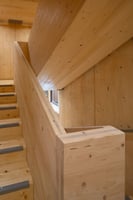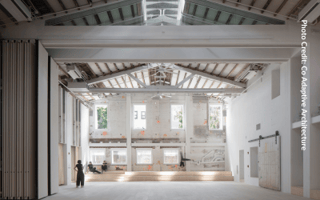Digital fabrication approaches that leverage Building Information Modeling (BIM) and Computer...
Design Experiments in Urban Areas: How CLT Can Redefine Architecture
“Cross-laminated timber (CLT) has the potential to reset the discipline of architecture.” This evocative statement by Jennifer Bonner, founder of MALL—a design practice centered on materiality, constructability, and conceptually driven ideas—references the transformative potential of CLT in single-family residential construction. With advanced prefabrication capabilities, streamlined construction, and material strength, CLT offers a sustainable and efficient solution for building homes in dense urban areas, appealing to both builders seeking tighter processes and homeowners looking for unique, expressive living spaces.
Haus Gables: A Case Study in CLT’s Possibilities
Located in Atlanta’s Old Fourth Ward neighborhood, Haus Gables exemplifies the innovative possibilities of CLT in urban residential design. This 2,200-square-foot home designed by Bonner takes its name from its defining feature: a clustered, six-gable roof. Built on a narrow 24-foot-wide lot with the house only 18-foot in width—no larger than a single-wide mobile home—Haus Gables demonstrates how designing with CLT can reimagine small urban spaces as inspired living environments.

CLT served as both the structural framework and the warm interior finish for Haus Gables' complex roof design.
Image Credit: Narro, Design: Jennifer Bonner, MALL
Bonner’s approach to Haus Gables is anything but conventional. Rejecting a traditional floor plan, she designed the home from the roof down, aligning the interior spaces with the geometry of the roof’s angles and pitches. CLT enabled the creation of a superstructure that brought her vision to life, with double-height spaces and steep gables allowing rooms to nest within the roof plan. The result is an open, dynamic interior that maximizes spatial efficiency and architectural expression.
CLT’s precision prefabrication capabilities proved essential to the project’s success. Using 87 prefabricated CLT panels, the construction team completed the structure in just 14 days. Panels were delivered and assembled in sequence, minimizing on-site clutter and maximizing efficiency on the compact lot. Haus Gables showcases how CLT can be leveraged to create intricate homes that combine bold design with practical construction methods. Bonner’s use of CLT to utilize space and geometry in unique, unconventional ways is covered further in the continuing education course, CLT in Residential Typologies.
The Business Case for Digital Prefabrication
The success of CLT projects like Haus Gables is a function of the power of digital prefabrication. Leveraging Building Information Modeling (BIM) workflows and Computer Numerical Control (CNC) machining, project teams can design and fabricate every detail with precision. These technologies streamline the construction process by allowing components to be cut to exact specifications and strategically delivered according to the erection sequence. Moreover, channels for the routing of MEP and other services can be factory machined, reducing time and costly errors onsite.

CLT coupled with digital fabrication technologies enables large-scale building components of complex geometry to be efficiently fabricated with millimetre precision.
In densely populated urban environments with limited space, digital prefabrication offers clear advantages. Materials arrive ready for assembly, reducing waste and minimizing the need for adjustments on-site. According to a McKinsey & Company report, prefabrication can accelerate project timelines by 20-50% while reducing material waste by 20-40%. Offsite fabrication also ensures better quality control and reduces the number of workers required on-site, making construction more efficient and cost-effective, as explained in the continuing education course, The Business Case for Building with Wood.
CLT’s structural strength further enhances its versatility. With its ability to span larger distances, CLT allows for open layouts and taller ceilings, giving architects the freedom to design spacious, functional living environments even in tight urban infill applications.
Transforming Residential Architecture
Projects like Haus Gables demonstrate how CLT can transform residential architecture, particularly in high-density neighborhoods with space-constrained sites. By integrating the precision of digital prefabrication, the onsite efficiency of assembling a kit-of-parts, and the natural appeal of exposed wood, CLT provides architects and builders with opportunities to create sustainable, space-efficient homes that generate new possibilities in residential construction.


